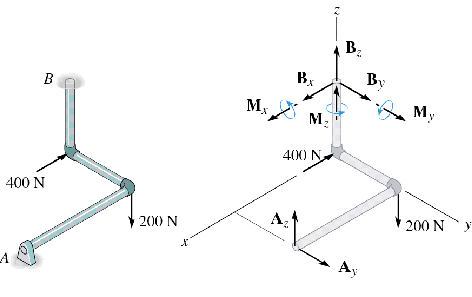

A diagram which portrays the free body, complete with the system of external forces acting on it due to its interaction with the parts which have been removed, is called the free-body diagram (FBD) of the isolated part.

The part which has been cut (imaginarily), forms a free body. The isolation enables us to see the interactions between the isolated part and the other parts. The isolation of a mechanical system is achieved by cutting and isolating the system from its surroundings. A mechanical system can be solid, fluid, or even a combination of solild and fluid. The bodies forming the system can either be rigid or non-rigid. The system can be formed by a single body, part of a body, or a group of connected bodies. In this section, we will see how a targeted part is isolated and how the free body formed through the isolation process is displayed graphically.Ī mechanical system is defined as a body system that can be isolated from other bodies. The part which is isolated is called a free body. The concept of isolating the part which is the target of analysis, is a very important concept in mechanical analysis. To see what actually happens to any particular part of a structure, that part has to be isolated from the other parts of the body. Mechanical analysis of a structure, in general, is started by applying Newton’s law to the whole structure, or to part of the structure. This tendency to rotate is called the “moment” and is measured quantitatively by the methods described in Chapter 2. Also, a force on on a body not only tends to cause the body to translate (as in the case of the particle) but also tends to cause the body to rotate about any axis which does not intersect with or is not parallel to the line of action of the force. In general, a force acting on a particle tends to cause the particle to translate. For the analyses ini this book, only the effects of the deformations of springs on a rigid body interacting with the springs are considered but the springs themselves will not be analysed as a body.ģ.1.3 Effects Of The Action Of Forces on Particles and Rigid Bodies Springs undergo deformations that cannot be neglected when acted upon by forces or moments. All bodies to be studied in this book are rigid, except for springs. Most bodies encountered in engineering work can be considered rigid from the mechanical analysis point of view becase the deformations that take place within these bodies under the action of loads can be neglected when compared to other effects produced by the loads. A body is said to be rigid when the relative positions of its particles are always fixed and do not change when the body is acted upon by any load (whether a force or a couple). The size of a body affects the results of any mechanical analysis on it. A body is formed by a group of particles. The size of a particle is very small compared to the size of the system being analysed.

A particle is a body whose size does not have any effect on the results of mechanical analyses on it and, therefore, its dimensions can be neglected. The ability to understand mechanics and many other engineering disiciplines is dependent on mastering the concept of equilibrium. The concept must be really understood by every student. The concept of equilibrium is the most basic and most important concept in engineering analysis. In statics, the concept of equilibrium is usually used in the analysis of a body which is stationary, or is said to be in the state of static equilibrium. There is no unbalanced force or unbalanced couple acting on it. A body under such a state is acted upon by balanced forces and balanced couples only. The concept of equilibrium is introduced to describe a body which is stationary or which is moving with a constant velocity. A free-body diagram shows the relative magnitude and direction of all forces acting upon an object in a given situation.įree-body diagram example - gravity and friction forces acting on a body on an inclined plane Example - Support Reactions on a Beam with Eccentric LoadĪ beam with length 6 m has an eccentric load of 9000 N 4 m from support 1.3.3 EQUILIBRIUM EQUATIONS FOR A RIGID BODY The best way to account for all forces acting on a body is to draw the body's free-body diagram. Often the loading of a body can be simplified to a two dimensional system with co-planar forces in the x-y plane. Static equilibrium in a three dimensional system can be expressed as

Equilibrium of a body requires both a balance of forces to prevent the body from translating or having accelerated motion along a straight or curved path - and a balance of moments to prevent the body from rotating.Īny static force system will be in equilibrium if the resultant force and resultant moment both are equal to zero.


 0 kommentar(er)
0 kommentar(er)
